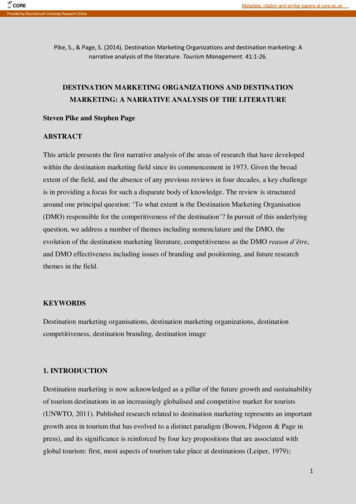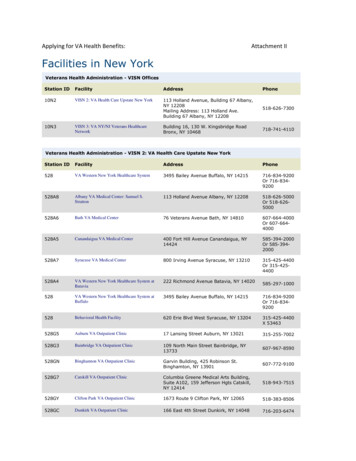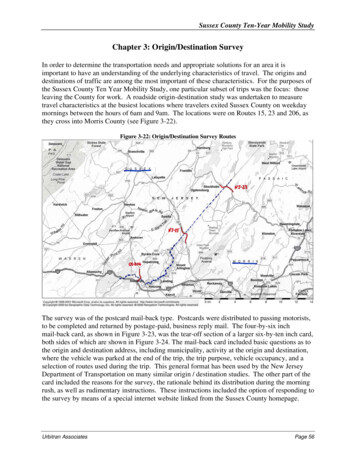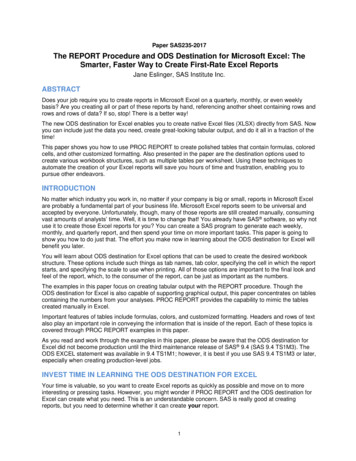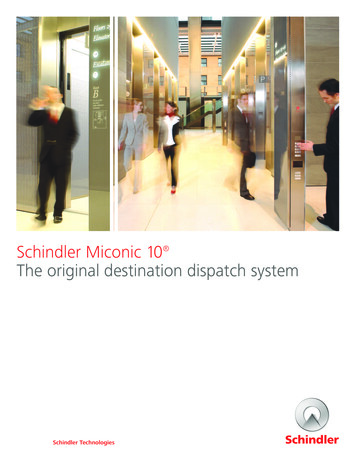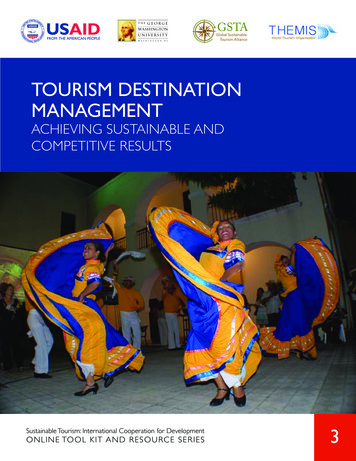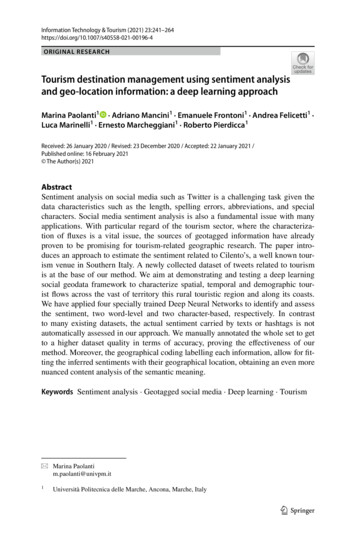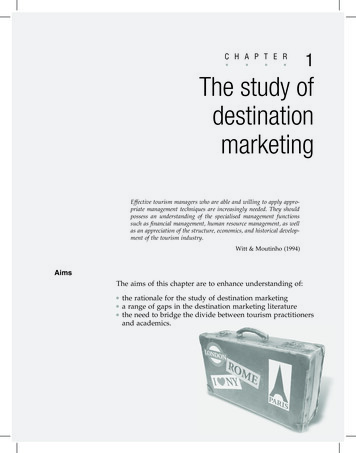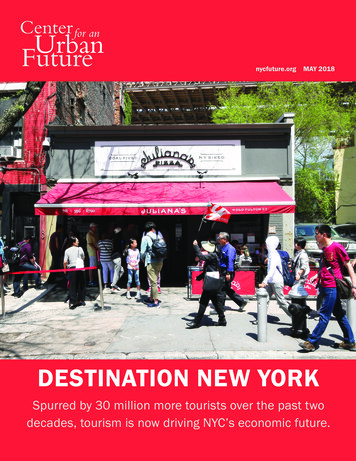
Transcription
nycfuture.orgMAY 2018DESTINATION NEW YORKSpurred by 30 million more tourists over the past twodecades, tourism is now driving NYC’s economic future.
DESTINATION NEW YORK is a publication of the Center for anUrban Future. Researched and written by Christian GonzálezRivera. Edited by Eli Dvorkin and Jonathan Bowles. Additionalresearch by Sheila Binesh, Julia Hotz, Leah Jacobson, Elsa vanLatum, Lucas dos Santos, and Shiming Xiong. Designed by RobChabebe.CONTENTSThis study was made possible by Times Square Alliance andthe Association for a Better New York.DESTINATION NEW YORKTimes Square Alliance, founded in 1992, works to improveand promote Times Square—cultivating the creativity, energy,and edge that have made the area an icon of entertainment,culture, and urban life for over a century.Association for a Better New York is a nearly 50-year-old civicadvocacy organization dedicated to improving the quality of lifefor those that live and work in New York City and for those whovisit. We work with the city, the state, and the federal government, as well as with our business and civic members, toachieve positive results for all of New York’s communities.Center for an Urban Future (CUF) is a leading New YorkCity–based think tank that generates smart and sustainable public policies to reduce inequality, increase economicmobility, and grow the economy.General operating support for the Center for an Urban Futurehas been provided by the Clark Foundation, the Bernard F. andAlva B. Gimbel Foundation, and the Altman Foundation. CUFis also grateful for support from Fisher Brothers for the MiddleClass Jobs Project.Executive Director: Jonathan BowlesPolicy Director: Matt A.V. ChabanManaging Editor: Eli DvorkinSenior Researcher: Christian González-RiveraSenior Fellow for Economic Opportunity: Tom HilliardCommunications and Operations Manager: Hayley KaplanSenior Fellow for Small Business and Entrepreneurship:Judith MessinaEvents and Operations Assistant: Angela SabblahResearch Associate: Naomi SharpVisiting Fellow: John SuricoBoard of Directors: Gifford Miller (Chairman), Michael Connor(Vice Chair), Max Neukirchen (Treasurer), John H. Alschuler,Margaret Anadu, Jonathan Bowles, Russell Dubner, LisaGomez, Jalak Jobanputra, Kyle Kimball, David Lebenstein, EricS. Lee, Monisha Nariani, Andrew Reicher, John Siegal, StephenSigmund, Thomas Vecchione, Robert ZimmermanCover photo: Matt A.V. Chaban3PORTRAIT OF A BOOM:THE IMPACT OF TOURISM ON NEW YORK CITY’S ECONOMY12A NEW ENGINE OF MIDDLE CLASS JOB GROWTH22AN ENTRY POINT TO OPPORTUNITY24CHALLENGES & THREATS TO NYC’S TOURISM ECONOMY25RECOMMENDATIONS31
DESTINATION NEW YORKNew York City’s economy has been on an unprecedented roll over the past two decades.There are nearly a million more jobs across the five boroughs today than in 1997, and the city’sunemployment rate now stands at less than half of what it was then.1 This extraordinary economictransformation was fueled by a number of factors, including the plunging crime rate and the techsector’s meteoric rise. But few things have been more important to the city’s extended economicboom—or more overlooked—than the record increase in tourists.Twenty years ago, around 33 million tourists visited New York City each year. These days, thecity routinely tops 60 million annual visitors.2 In 2017 the city hit a record high of 62.8 millionvisitors.3This remarkable surge in tourism has done more than merely clog sidewalks in Times Square.It has sparked hundreds of thousands of new jobs—not just at hotels, but in restaurants, retailshops, museums, airports, tour bus companies, and even travel tech start-ups. In the process, tourism has been elevated from a fairly important part of the city’s economy to one of the four leadingdrivers of job creation in New York. Indeed, tourism now accounts for about as many jobs as thecity’s tech sector, the creative economy, or the finance industry.Tourism has also become an increasingly vital source of new middle-income jobs. As just oneexample, the city is now home to nearly as many accommodations jobs, which pay 62,000 peryear on average, as jobs in manufacturing, which pay an average of 58,000.4 To be sure, many ofthe jobs in the sector offer relatively low wages, at least to start. But tens of thousands of tourismpositions provide critical entry points into the labor force for a highly diverse range of New Yorkers. Indeed, no other sector offers as many accessible jobs, with 91 percent of tourism jobs opento workers with less than a bachelor’s degree.5 The tourism sector also reflects the diversity of thecity. More than 65 percent of New York City residents who work in tourism-related industries arepeople of color and 54 percent are immigrants, compared to 59 percent and 44 percent, respectively, of workers in other sectors.6Despite the increasing importance of tourism to the city’s economic future, our research suggests that New York’s tourism sector faces several new and evolving challenges—from the strongdollar and the effect of international travel restrictions to air traffic congestion and the city’s agingtransportation infrastructure—that could cause reductions in tourism and a decline in jobs. It’salso an industry full of opportunity. Although some industries in New York could be displaced byautomation in the decade ahead, global tourism is expected to grow even further as more than abillion people around the world join the middle class.But taking advantage of these opportunities—and addressing the growing number of threats—will require a new level of planning from city and state government.Destination New York3
This report captures the far-reaching impact oftourism on the city’s economy, details the challengesthreatening the sector’s continued vitality, and advances ideas to cultivate and sustain New York’s tourismboom in the years ahead. Funded by the Association fora Better New York and Times Square Alliance, the studydraws from an extensive analysis of economic and census data as well as interviews with more than 60 policymakers, business executives, and tourism professionalsfrom across New York City. In addition, researchers atthe Center for an Urban Future spoke with more than100 owners and workers at businesses across all fiveboroughs—including restaurants, retailers, hotels,tour companies, and even travel-focused tech startups—in order to better understand the effects of tourism on every corner of the city and its economy, and thechallenges facing tourism in the years ahead.According to Tourism Economics, the firm thatproduces tourism figures and analysis for NYC & Company, the tourism and hospitality sector directly employs 291,084 people in the five boroughs—about oneout of every eleven workers in the city.7 That puts tourism in the same league as the biggest industries in NewYork City.While healthcare is by far the city’s largest industry, employing 488,000 New Yorkers, tourism and hospitality now directly employs more New Yorkers thanthe finance sector (268,200 jobs). Tourism also hasmore than twice as many jobs as the city’s tech sector(128,600 jobs) and nearly as many as the broader techecosystem (326,000). It greatly outnumbers jobs in theeducation sector (178,300), has more than four timesas many jobs as manufacturing (75,300), and employsroughly the same number of people as the city’s creative economy (295,000), which includes nine creativeindustries—from advertising and architecture to film/television production and performing arts.8Jobs that are fueled by tourism have grown fasterthan the city’s overall economy in recent years. From2009 to 2016, direct tourism jobs increased 27 percent,from 228,948 to 291,084, compared to 20 percentoverall job growth.9 In several of the industries thathave benefited from the tourism boom, job growth hasbeen even more significant.Due to changes in how Tourism Economics gathers its data made roughly a decade ago, it’s not possibleto contrast the sector’s growth before 2009 with thatof the broader city economy. However, our analysis ofdata from the New York State Department of Laborshows that employment in the accommodations sectoralone has expanded by 46 percent from 1997 to 2017.During the same period, employment in the city’s “lei4sure and hospitality” sector—which includes hotels,restaurants, arts, and entertainment—increased bya remarkable 98 percent, going from 227,900 jobs in1997 to 452,100 in 2017. 10While the majority of tourism jobs are based inthe Manhattan neighborhoods that are home to a disproportionate share of the city’s tourism infrastructure, the fastest employment growth is occurring inthe other four boroughs. Since 2000, Brooklyn added1,294 accommodations jobs (a 198 percent increase)while Queens added 876 (37 percent). Staten Islandadded 279 jobs (317 percent), and the Bronx added161 jobs (52 percent). Manhattan, meanwhile, added9,515 accommodations jobs, a 27 percent gain. Moreover, 81 percent of the New York City residents whoare employed at hotels live in the four boroughs outsideManhattan. Queens is home to 14,750 hotel workers,followed by Brooklyn (10,986), Manhattan (8,324), theBronx (6,881), and Staten Island (1,819).11Boosting key sectors of New York City’s economyThe full impact of tourism on New York’s economy isbest seen by its reach. Most New Yorkers understandthat tourism leads to job creation at hotels, theme restaurants like Bubba Gump Shrimp Co., and attractionssuch as Madame Tussauds wax museum. But this reportdocuments that tourism has also been responsible fora significant portion of the job creation in many of thecity’s fastest-growing industries, including restaurantsand bars (which added 142,000 jobs since 2000), retail(which had a net gain of 71,000 jobs), and arts, entertainment, and recreation (which grew by 30,000 jobs).12For instance, the number of jobs in restaurantsand bars has exploded over the past two decades, withemployment increasing 91 percent since 2000.13 Although a healthy share of this growth is attributableto the city’s increasing population and rising incomes,our analysis shows that nearly half the gains could stemfrom tourist demand. Domestic and international tourists are responsible for 24 percent of all sales at NewYork City restaurants and drinking places, accordingto our analysis of Visa credit card transactions madeby people coming from outside of the New York CityMetropolitan Statistical Area (MSA).14 Many restaurateurs we interviewed across the city—not just in TimesSquare—report that more than half of their customersare tourists—in some cases, upward of 90 percent. In2016, tourists spent 9.1 billion at food and drinkingestablishments, up 35 percent since 2009, after adjusting for inflation.15“Without a doubt tourism has fueled our restaurants, and that has allowed us to employ more people,”Center for an Urban Future
Total Visitors to NYC, 1998–201762.8656058.5Visitors 98 1999 2000 2001 2002 2003 2004 2005 2006 2007 2008 2009 2010 2011 2012 2013 2014 2015 2016 2017Source: NYC & Companysays John Meadow, president of LDV Hospitality, whichowns several restaurants and bars downtown, includingScarpetta, Lugo, and The Lately. “I can’t stress enoughhow tourist volume helps maintain topline revenues inthe face of the increasing expenses of running a restaurant in New York City. In the restaurant business wesay that volume heals all wounds.”Tourists have also been a huge contributor to thegrowth of the city’s retail sector, which has added nearly 71,000 jobs since the year 2000.16 Tourists accountfor nearly one-fifth of all Visa credit card purchases atthe city’s retail stores.17 Across many parts of the city,the impact of tourists on retail is even larger. In ourinterviews with more than 100 retail store owners andmanagers in popular shopping corridors from SoHoand lower Fifth Avenue to Williamsburg and Dumbo,the average retailer told us that tourists account for30 to 40 percent of all customers. “I’d say that 42 to43 percent of the growth in retail is due to tourists,”says Faith Hope Consolo, chair of the retail division atDouglas Elliman Real Estate.Tourists, on average, devote 20 percent of theirbudgets to shopping.18 International tourists, especially, tend to make big purchases, stocking up on thingsthey can’t find at home or which cost significantlymore, from designer suits at Bloomingdale’s to iPhonesat the Apple Store or diamond rings at Tiffany. Indeed,Destination New Yorkwithin the retail sector, job growth has been strongestin many of the categories that are most popular withtourists.19 Our research shows that tourists accountfor 48 percent of the credit card spending at the city’slarge department stores and 35 percent of spendingat electronics stores.20 International tourists alone areresponsible for 29 percent of sales at the city’s jewelry stores. They also account for a significant shareof spending at art dealers and galleries (29 percent),camera and photo supply stores (28 percent), clothingstores (21 percent), antique shops (25 percent), candystores (18 percent), shoe stores (14 percent), sportinggoods stores (12 percent), and cosmetics shops (12 percent). All this spending has created jobs. For instance,while retail jobs have grown by 26 percent overall, jobsin “general merchandise” stores, of which departmentstores are the major subcategory, have increased 39percent—adding almost 12,000 jobs.21In recent years, tourism has begun to play another critical role: a dependable source of sales at a timewhen many retailers are facing increasing pressuresfrom online retailers. In the face of these headwinds,many retailers say that the city’s tourists have made upthe difference and even allowed for further growth incategories such as fashion, electronics, cosmetics, andluxury goods.5
Employment in Tourism and Other LeadingJob-Generating Industries in 0075,300HealthcareTech Ecosystem C
Center for an Urban Future (CUF) is a leading New York City–based think tank that generates smart and sustain-able public policies to reduce inequality, increase economic mobility, and grow the economy. General operating support for the Center for an Urban Future has been provided by the Clark Foundation, the Bernard F. and Alva B. Gimbel Foundation, and the Altman Foundation. CUF is also .
